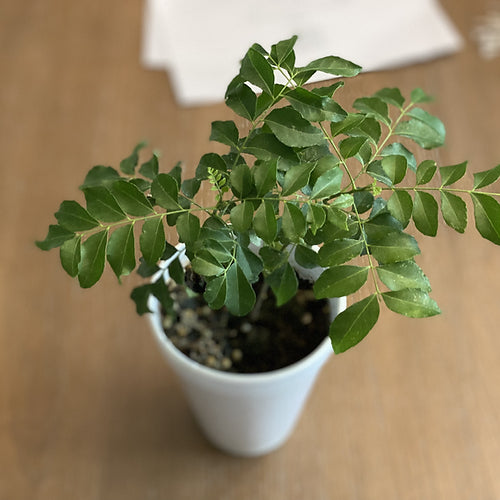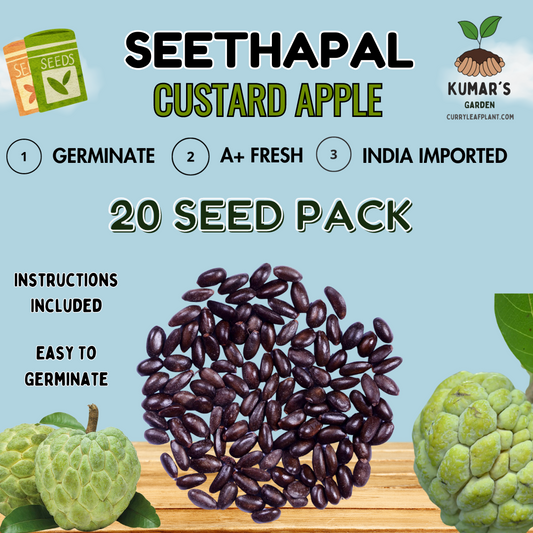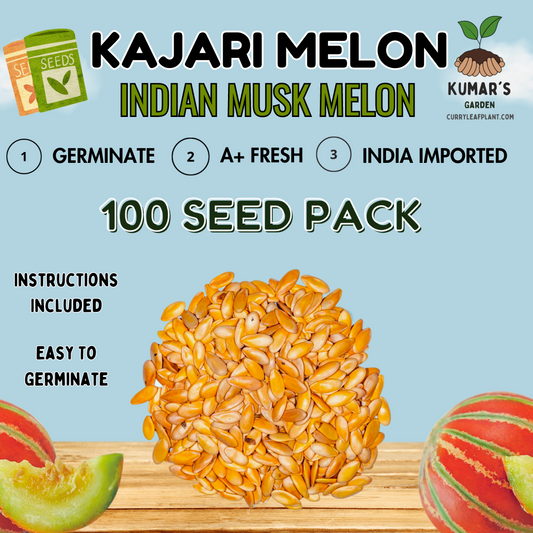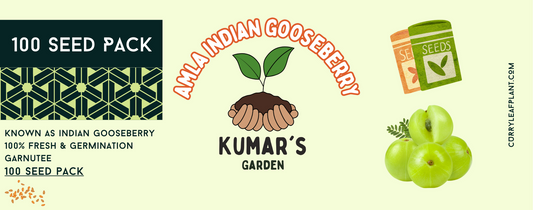In this Guide You Will Find, How To Prune Curry Leaf Plants
Introduction
The curry leaf plant (Murraya koenigii) is a beloved addition to many gardens and kitchens, known for its aromatic leaves that impart a unique flavor to various dishes, especially in Indian cuisine. To ensure your curry leaf plant thrives and continues to provide fresh leaves for your culinary adventures, it's essential to understand the importance of pruning. In this comprehensive guide, we'll walk you through the process of pruning a curry leaf plant, from the basics to advanced techniques, so you can keep your plant healthy, vibrant, and productive.
Understanding the Curry Leaf Plant
Before we delve into the pruning process, let's get acquainted with the curry leaf plant:
Botanical Information and Characteristics
The curry leaf plant is a small tropical tree native to India and other parts of Southeast Asia. It belongs to the Rutaceae family and can reach a height of 15 to 20 feet when grown in ideal conditions. The plant's most distinctive feature is its pinnate leaves, which are highly aromatic and packed with flavor.
Growing Conditions and Requirements
To cultivate a healthy curry leaf plant, ensure it receives the following:
- Sunlight: These plants thrive in full sunlight but can tolerate partial shade.
- Temperature: They prefer warm and tropical climates.
- Soil: Well-draining soil rich in organic matter is ideal.
- Watering: Water consistently but avoid waterlogged soil.
- Fertilization: Apply balanced fertilizer during the growing season (spring and summer).
Benefits of Having a Curry Leaf Plant
Besides enhancing the flavor of your culinary creations, curry leaf plants offer several other benefits:
- Medicinal Properties: Curry leaves have various medicinal properties and are used in traditional medicine for their antioxidant and anti-inflammatory effects.
- Aesthetic Appeal: The plant's lush green foliage adds beauty to your garden or indoor space.
- Aromatherapy: The fragrance of curry leaves can create a calming atmosphere.
Pruning Basics for Curry Leaf Plants
Now, let's dive into the fundamentals of pruning and why it's crucial for curry leaf plants. Pruning is the same a trimming. This will help your plant double in the amount of "shoots" it has which allows more leaf growth in the future, you can do this every year which will then 2x, 4x, 8x the amount of main branches it creates!
What is Pruning?
Pruning is the process of selectively removing parts of a plant, such as branches, leaves, or stems. In the case of curry leaf plants, pruning helps maintain their shape, remove dead or diseased growth, and promote new growth.
Why is Pruning Important for Curry Leaf Plants?
Pruning serves several essential purposes for curry leaf plants:
- Enhanced Health: Removing dead or diseased branches prevents the spread of diseases and improves overall plant health.
- Improved Appearance: Pruning helps maintain a neat and attractive appearance.
- Promotion of New Growth: Proper pruning encourages the plant to produce new branches and leaves, ensuring a continuous supply for culinary use.
When to Prune: Seasonal Considerations
The best time to prune your curry leaf plant is during the growing season, typically in spring or early summer. Avoid heavy pruning during the dormant winter months when the plant experiences slower growth.
Tools and Materials
Before you start pruning, gather the following tools and take necessary safety precautions:
List of Necessary Tools
- Recommended Pruning shears or scissors: Essential for making clean cuts.
- Best Pruning saw: For thicker branches if needed.
REXBETI Folding Saw, Heavy Duty 11 Inch Extra Long Blade
- Gardening gloves: Protect your hands from thorns and sap.
- Clean and disinfected pot (if repotting is required): Ensure the pot is ready if you need to repot your plant.
- Curry Leaf Plant fertilizer: For post-pruning care.
Safety Precautions
- Wear gloves: Protect your hands from thorns and potential irritants.
- Use clean and sharp tools: Clean and disinfect your pruning tools to prevent the spread of diseases.
- Work in good light: Adequate lighting will help you make precise cuts.
Step-by-Step Pruning Guide
Now that you have your tools and safety measures in place, let's proceed with the step-by-step pruning process:
Step 1: Assess the Plant
Begin by assessing the overall health of your curry leaf plant:
- Examine overall health: Inspect the plant for signs of disease, such as yellowing leaves, mold, or pests.
- Identify dead or diseased branches: Locate and mark any branches that appear dead or unhealthy.
:strip_icc()/fireblight-crabapple-bbd92494-baa4727f17d6491fa7d512ba1b3a6211.jpg)
Step 2: Gather Your Tools and Prepare the Workspace
Before you begin pruning, ensure you have all the necessary tools within reach. Select a clean and clutter-free workspace to work comfortably.
Step 3: Prune Dead or Diseased Branches
Properly removing dead or diseased branches is crucial for the plant's health:
- Use proper cutting technique: Make clean cuts just above leaf nodes, at a 45-degree angle, to encourage new growth.
- Removing dead leaves: Trim off any dead or yellowing leaves as well.
Step 4: Prune for Shape and Size
Control the height and width of your curry leaf plant to maintain its desired shape:
- Controlling height and width: Trim the top growth to control height and selectively prune branches on the sides to manage width.
- Promoting branching: Encourage a bushier appearance by selectively trimming.
Step 5: Thin Out Overcrowded Growth
Overcrowded growth can lead to issues like poor air circulation and pest problems:
- Identifying crowded areas: Locate areas with dense growth.
- Selective removal of branches: Trim away excess growth to allow better airflow and light penetration.
Step 6: Maintain a Balanced Shape
Avoid over-pruning and encourage new growth:
- Avoiding over-pruning: Never remove more than one-third of the plant's foliage at once to prevent stress.
- Encouraging new growth: Cutting just above leaf nodes promotes fresh growth.
Step 7: Final Touches
Complete the pruning process with these final steps:
- Cleaning up debris: Remove trimmed branches and leaves from the workspace.
- Applying fertilizer if necessary: Provide nutrients to support new growth.
Caring for the Curry Leaf Plant After Pruning
Your work doesn't end with pruning. Follow these post-pruning care tips:
Watering and Fertilizing Post-Pruning
- Water your curry leaf plant thoroughly after pruning to reduce stress.
- Apply organic fertilizer during the growing season to encourage new growth and maintain plant vigor.
Monitoring the Plant's Recovery
Keep a close eye on your curry leaf plant in the days and weeks following pruning. Watch for signs of new growth and monitor the plant's overall health.
Common Issues and Troubleshooting
Be prepared to address common issues that may arise after pruning, such as potential pest problems or nutrient deficiencies. Timely intervention can help maintain the plant's well-being.
Pruning Frequency and Signs for Curry Leaf Plants
You may wonder how often you should prune your curry leaf plant and when it's time for another pruning session:
How often should you prune a curry leaf plant?
- Prune your curry leaf plant annually during the growing season
FAQ Section
-
What is a curry leaf plant, and why is it popular?
- A curry leaf plant (Murraya koenigii) is a small tropical tree native to India known for its aromatic leaves used in various culinary dishes. It's popular for adding a distinct flavor to curries and other Indian recipes.
-
Why is pruning important for a curry leaf plant?
- Pruning is essential for a curry leaf plant to maintain its health, shape, and productivity. It helps remove dead or diseased growth, promotes new growth, and prevents the plant from becoming overgrown and leggy.
-
When should I prune my curry leaf plant?
- Prune your curry leaf plant during the growing season, typically in spring or early summer. Avoid heavy pruning during the dormant winter months.
-
What tools and materials do I need for pruning my curry leaf plant?
- You will need sharp pruning shears or scissors, gardening gloves, a clean pruning saw for thicker branches, a clean and disinfected pot for repotting if needed, and organic fertilizer.
-
How do I assess the health of my curry leaf plant before pruning?
- Examine the plant for signs of disease, such as yellowing leaves or mold. Check for dead or wilting branches and remove them. Ensure the plant is actively growing.
-
What is the correct technique for pruning curry leaf plants?
- Use clean and sharp pruning shears to make clean cuts just above leaf nodes. Cut at a 45-degree angle to encourage new growth. For thicker branches, use a clean pruning saw.
-
How can I prune my curry leaf plant to control its height and width?
- Trim the top growth to control height and selectively prune branches on the sides to manage width. Regular trimming will help maintain the desired shape.
-
Why is it important to thin out overcrowded growth when pruning?
- Overcrowded growth can lead to reduced air circulation and light penetration, which can encourage pests and diseases. Thinning out overcrowded areas allows for better plant health.
-
How can I maintain a balanced shape while pruning my curry leaf plant?
- Avoid over-pruning by never removing more than one-third of the plant's foliage at once. Encourage new growth by cutting just above leaf nodes, which will help maintain a balanced shape.
-
What should I do after pruning to care for my curry leaf plant?
- Water the plant thoroughly after pruning and apply organic fertilizer to encourage new growth. Monitor the plant's recovery and address any issues promptly.
-
How often should I prune my curry leaf plant?
- Prune your curry leaf plant annually, typically during the growing season in spring or early summer. However, you may need to perform light maintenance pruning as needed throughout the year.
-
What are the signs that indicate it's time for another pruning session?
- Look for signs of overgrowth, leggy branches, or reduced foliage density. If the plant starts to lose its desired shape or becomes too tall and unruly, it's time for another pruning session.
-
What are the benefits of proper pruning for a curry leaf plant?
- Proper pruning promotes healthier growth, better air circulation, and increased sunlight exposure for the plant. It also helps maintain the desired size and shape and extends the plant's lifespan.










